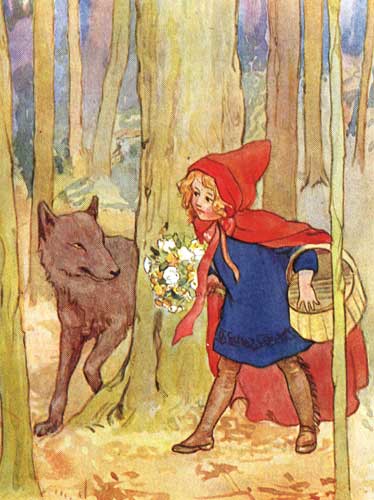
I thought it might be fun this month to re-post some of my most popular fairy tale posts. The post on Perrault’s “Little Red Riding” from 2010 has the most all time view of any of my posts.
Perrault’s version of “Little Red Riding Hood” was first printed in 1697, and varies a little from the more familiar Grimm’s version, told in the 19th century.
Little Red Riding Hood, a “little country girl, the prettiest ever seen,” was given her nickname because of the red hood that her grandmother had made. Notice that the cloak is red, a vibrant color often associated with sexuality and with blood.
Anyway, one day Red Riding Hood is sent by her mother to her grandmother’s house in the next village with a cake and some butter, since her grandmother has been feeling ill. Along the way, she meets the wolf who wants to eat her but comes up with a better plan. He asks her where she is going. She tells him and he responds that he will go there too and they will see who gets there first.
Of course, the wolf is the first to arrive. He pretends to be Red Riding Hood so that the grandmother invites him in. He promptly eats the grandmother. When Red Riding Hood knocks, the wolf tells her to come in and the girl, assuming it is her grandmother and that her voice sounds hoarse because she has been ill, enters.
The wolf, seeing her come in, said to her, hiding himself under the bedclothes, “Put the cake and the little pot of butter upon the stool and come get into bed with me.”
Little Red Riding Hood took off her clothes and got into bed. She was greatly amazed to see how her grandmother looked in her nightclothes…
Then the story goes into the usual questions and answers about her arms, legs, ears, eyes and finally teeth. At that point the wolf eats Red Riding Hood and the story ends. That part is the the one I never knew though, the “get into bed with me.” It makes sense that it’s left out of the children’s versions today, although more and more books have heroines getting into bed with were-wolves, which is pretty much the same. The attraction of danger, but the charm too.
Perrault’s version has no wood cutter to come save the day. Red Riding Hood and her grandmother are devoured, period. Perrault does include a moral, though, in case the reader missed the point of the story.
Moral: Children, especially attractive, well bred young ladies, should never talk to strangers, for if they should do so, they may well provide dinner for a wolf. I say “wolf,” but there are various kinds of wolves. There are also those who are charming, quiet, polite, unassuming, complacent, and sweet, who pursue young women at home and in the streets. And unfortunately, it is these gentle wolves who are the most dangerous ones of all.
As a child, I obviously never realized this was a story filled with sexual innuendo. Perrault’s moral points it out rather clearly, though, doesn’t it? It’s not about being aware of the wild animals in the forest, it’s the men a girl meets in her daily travels, in the streets of her town, that she needs to be wary of.
Don’t get in bed with a wolf. They’re dangerous. Some of the interpretations see the devouring as rape. Others suggest that it’s a warning against becoming a prostitute. She was after all wearing a red cloak, a classic symbol of prostitution in 17th century France according to Wikipedia. For that matter, we are still aware of the term “red-light” district.
You can find both Perrault’s and the Grimms’ version at Sur La Lune, a website that I love.
Thursday’s Tales is a weekly event here at Carol’s Notebook. Fairy tales, folktales, tall tales, even re-tellings, I love them all. Feel free to join in.

I am pretty sure she would have become dinner even if she had not talked to him